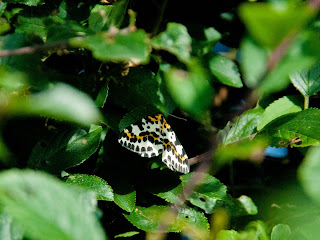Sunday, July 31, 2011
beauty and the beast
a crab spider has caught a meadow brown and is hauling it up to the flower head. Not all is beauty and light in the meadows.
Labels:
Inny valley,
insect life,
meadows
knap hand
although it is common, as this photograph shows, knapweed brings a blaze of brilliant purple colour to the meadows in late summer (a prize to anyone who can name every flower in this photo).
PS .... prizes are always photos of Spot :-)
PS .... prizes are always photos of Spot :-)
Labels:
meadows
silver washed out
There were a lot of silver washed fritillaries out today in the sun. They seem to prefer meadows and grassland that lie next to woods. They are large and powerful fliers and are usually quite skittish, but the top photo is of a female who was prepared to pose for me with the sun shining through her wings. The male in the lower photograph is feeding on hemp agrimony instead of the preferred food of brambles which have almost finished flowering.
Labels:
Inny valley,
insect life,
meadows
Saturday, July 30, 2011
small and vulnerable
A very juvenile blue tit (only a very few blue feathers on its head) recovering from an encounter with a window. Although very shocked it eventually recovered enough to fly off.
Labels:
birds
Wednesday, July 27, 2011
a very shy visitor
Jays may be very noisy birds but they are also generally very shy, and only very occasionally come into our garden (see link). The local magpies were very unhappy about this intruder and tried to chase it off.
We also spotted this magpie moth yesterday, although its colouration might suggest that leopard moth would be a better description.
Labels:
birds,
insect life,
Venterdon
Sunday, July 24, 2011
disappearing peacock
we are now in butterfly count fortnight, and the butterfly conservation group have reported an "alarming" drop in the number of peacock butterflies. So it was heartening that we saw 5 or 6 individuals this morning, once it had warmed up a bit. The bramble flowers on which a lot of bigger butterflies tend to feed have already come and gone this year, and the knapweed has not quite come into flower yet so there seems to be a gap in available food for these insects. This butterfly is feeding on a species of thistle.
Labels:
butterflies,
insect life
Tuesday, July 19, 2011
kings of their castles
Labels:
flora,
insect life
Thursday, July 14, 2011
in the meadows
soft light and a myriad of spiders' webs filled the meadows early this morning, as did the chattering of a family of long tailed tits enjoying the warmth of the sun
Labels:
birds,
Inny valley
Monday, July 11, 2011
occasional visitors
Another very occasional visitor to the peanuts is this nuthatch, adopting its characteristic upside down feeding posture, much to the surprise of the juvenile blue tit.
Labels:
birds
Saturday, July 09, 2011
butterfly news
just in time for the big butterfly count (see link) more species of butterfly are appearing; today in the meadows we saw large whites, small whites, meadow browns, ringlets, silver washed fritillaries, small skippers, and red admirals, in addition to the three above from the top a bright comma , a small copper, and a painted lady showing her under wear. No blues, tortoiseshells, brimstones or peacocks possibly because it was quite early in the morning.
Labels:
Inny valley,
insect life
a rare sight
We know that hedgehogs live in our garden but we only see them very occasionally at night. It is extremely unusual to see them ambling around in broad daylight like this one, completely unconcerned by our (four dogs and one person) return. The rain has brought out a lot of slugs so maybe this hedgehog was too busy snacking to notice the time of day.
Labels:
wildlife
Sunday, July 03, 2011
in greenscombe woods
It was a warm sunny day but not much to see apart from cornish bladderseed and the strange slender variety of betony that is only to be found in these woodland meadows.
Labels:
Greenscoombe,
Luckett
just like a leaf
the first of the second generation of brimstones to appear this year. The first silver washed fritillaries have also appeared in the last few days
Labels:
insect life
Saturday, July 02, 2011
five or six
the 3 main varieties of burnet moth are the five, narrow bordered five, and six spot. As far as I can tell this is the five spot (and only experts can tell the difference between this and the narrow bordered five spot). They are very striking in flight when they appear like a blurry ball of red (not black).
the middle picture is of a heart and dart moth. The dart is the black streak, and the heart is the round brownish mark towards the edge of each wing. The bottom picture is of a silver y moth, a frequent migrant to Britain. The picture looks slightly blurred. This is because this moth has the habit of rapid trembling when at rest.
Labels:
insect life
Subscribe to:
Posts (Atom)



























